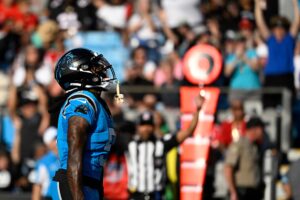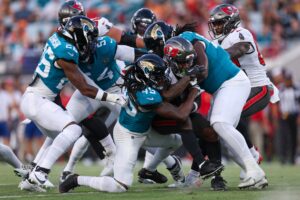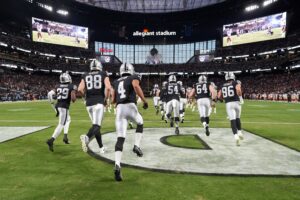The dust of the 2019 NFL free agency is starting to settle and some mustaches have even returned to their original color. Football free agency is an entertaining frenzy that baseball can only dream of.
Now that the bulk of the free agency signings are complete, the work begins. It’s time to analyze some of the moves for fantasy football purposes.
Here, we are going to look at the San Francisco 49ers backfield and determine who’s fantasy star shines the brightest.
Fantasy Football: Tevin Coleman or Jerick McKinnon
Jerick McKinnon
Disappointment followed Jerick McKinnon from Minnesota to San Francisco, albeit disappointment of a different variety. On two separate occasions “Jet” took a backseat role in lieu of another running back (Matt Asiata then Latavius Murray) for the starting nod. When the 49ers came calling with a good contract, it seemed as if McKinnon was finally getting the opportunity that both he and his fantasy owners were craving: a chance to be the feature back. Disappointment struck again, this time in the form a torn ACL during the preseason. McKinnon subsequently sat out the entirety of the first year of his contract.
McKinnon served as the third-down/passing-down specialist for the Minnesota Vikings from 2014 to 2017. During that span, he only missed six games. In 58 games, he has rushed for 1,918 yards (4.0 yards-per-carry), seven rushing touchdowns and only three fumbles. He also had 142 receptions on 191 targets (74.3 percent catch rate) for 984 yards and five touchdowns. McKinnon excels at taking short receptions into open space for chunk yards. Where he struggles is in yards-per-carry, especially at a higher volume. The two seasons where his YPC dipped below 4.0 were both seasons where he saw more than 150 rushing attempts. McKinnon is great in space, but not as effective between the tackles. He’ll get what’s blocked for him, but not too much more.
Tevin Coleman
Reunited and it feels so good! It does not take an advanced degree in drawing straight lines to see the connection between head coach Kyle Shanahan and Tevin Coleman. Shanahan actively pursued grabbing Coleman in free agency. The two have some history together. Shanahan served as the offensive coordinator for the Atlanta Falcons during the 2015 and 2016 seasons, respectively. That period saw the one-two punch of Devonta Freeman and Coleman and culminated in a trip to a Super Bowl. Both were viable fantasy assets that season. While Freeman had a higher ceiling, Coleman came at a serviceable discount yet still produced. He finished the 2016 season with 11 touchdowns despite only rushing for 520 yards.
Coleman saw an increase in workload last season due to an injury to Freeman and finished with a healthy 4.8 yards per carry, 800 rushing yards, and nine total touchdowns. Coleman represents a similar style back to McKinnon but does better between the tackles.
Matt Breida
Matt Breida ended last season with more times mentioned on the injury report than touchdowns. If Breida had the questionable tag, he should have been in starting lineups anyway. His 5.3 yards per carry average was ridiculous and despite seeing fewer targets, finished with more receiving yards than his previous season. His intended designation was to be the third-down back, but with an injury to McKinnon and later to Raheem Mostert, he carried more of the workload than anyone had intended or was expecting.
Breida is a talented dual-threat back but should maintain a more limited role due to his smaller stature. He’s not built to carry a work-horse role, which was evident last season despite his Robocop style of success.
Mining Through the 49ers Backfield
Having four capable running backs is terrible for fantasy football purposes. While it adds depth for real football, the fantasy folks suffer varying degrees of perturbed trying to guess who’s hot-hand has the stat-filled week. While the 49ers have four capable backs on the roster right now it’s doubtful that it stays that way through the offseason.
It is entirely possible that McKinnon gets either cut or traded and if so, it would be very soon. The guaranteed money portion of his four-year contract is already paid. The 49ers only owe him his annual salary if he’s on the active roster on April 1st. Meaning, they very well might be taking offers and making plans to part ways with him. That coupled with the statistical difference in production between him and Coleman certainly lends to the idea. Despite playing in two fewer games, Coleman has put up better career numbers in most statistical categories than McKinnon.
Coleman has 2,340 rushing yards on 528 attempts to McKinnon’s 474 attempts yielding 1,918 rushing yards. McKinnon has more targets with 191 to Coleman’s 134. However, Coleman has 1,010 receiving yards to McKinnon’s 984 despite the 57 fewer targets.
Coleman and Mostert both just got paid. That leaves Breida, who’s on the last year of his undrafted rookie deal which would pay out a base salary of $645,000. He’d be cheap to cut, which is unlikely as he’d be more valuable to trade. Teams may be inquiring on acquiring McKinnon, they also may be sniffing around Breida as well.
Last Word on the 49ers Backfield
Shanahan has always preferred a split backfield, which is okay for fantasy, but not preferred, as long as it’s not a three-way split with a similar style of backs. His offense has always been productive from the running back perspective. It’s expected that as this unfolds, there are one or two running backs on this offense worth drafting for fantasy. However, if things remain as they currently are, this backfield is murky. The statistical difference between McKinnon and Coleman is close, yet Coleman remains the more efficient and productive back. Early ADP has McKinnon at RB23, Coleman at RB29, and Breida at RB31. However, it would not shock me if the 49ers part ways with McKinnon in favor of Coleman. Either way, when the dust settles, Coleman should rise to the top and operate as the lead back in this offense and fall within RB2 range. Assuming it plays out that way, Breida remains a solid flex option for PPR formats.






